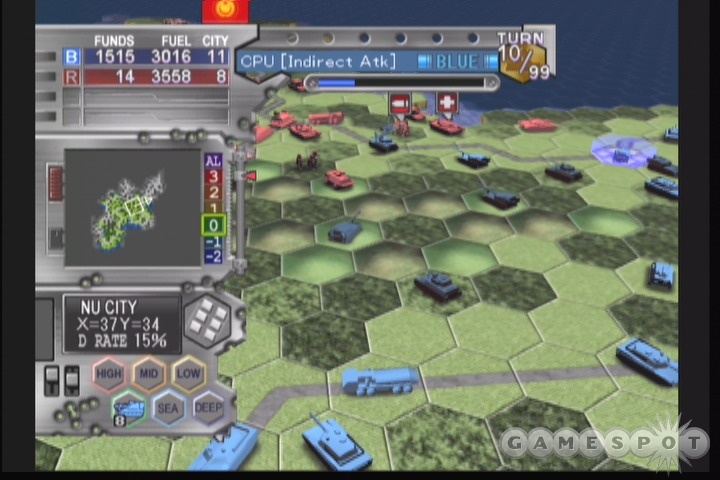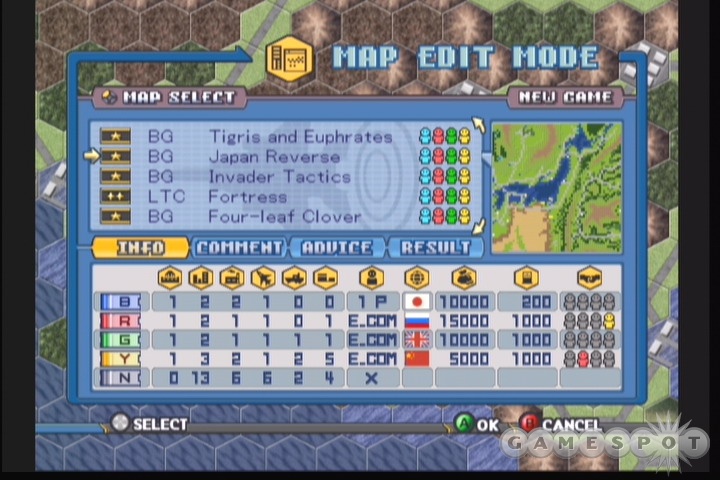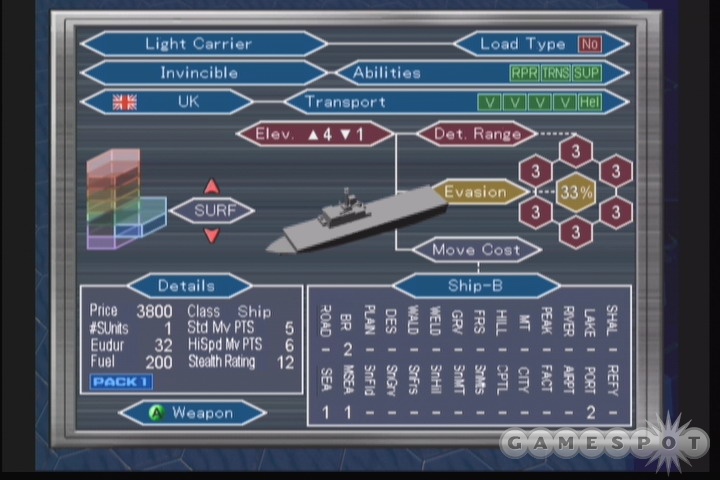At last, the wait is finally over! But, seriously. You can tell just from the title that Dai Senryaku VII: Modern Military Tactics isn't exactly aiming to be the game to cause the nation's Xbox owners to shelve their copies of Halo 2. This is a complex, complicated turn-based wargame featuring literally hundreds of authentic modern military units, as well as a big campaign, dozens of stand-alone scenarios, and a full-fledged map editor. And, for good measure, the game features a budget price. So, for what it is, Dai Senryaku VII absolutely delivers. The fact that this is the seventh installment of a long-running series of such games is evident from the quality of the design, which actually makes such a deep strategic experience relatively easy to get into.

Note the operating word there is "relatively." Dai Senryaku VII is actually quite slick and streamlined for a wargame, but it'll likely be daunting on first impression, even if you consider yourself a fan of strategy games. That's because of the sheer breadth of content it has to offer. Fortunately, a 50-page manual, a meticulous step-by-step tutorial, and a campaign that starts off nice and simple should help you get over the learning curve fairly quickly. Dai Senryaku VII is comparable to various wargames for the PC, but comparisons will sooner be drawn to the outstanding Advance Wars games for the Game Boy Advance, which succeeded at distilling turn-based strategy to its purest, most entertaining form. This is definitely a similar experience, though it's a lot more complicated than Advance Wars and lacks the charm and character of that series. Nevertheless, if you're up for marshaling vast armies of infantry, tanks, artillery, aircraft, ships, and more, as well as using these units to sweep across vast tactical maps to outsmart and outmaneuver your enemy, this is your game.
Combat is the focus of Dai Senryaku VII, and it's actually pretty intuitive. You'll take on from one to three different opponents on a given map, and you'll easily be able to distinguish between them based on their colors. You'll win or lose on account of your military units. Most units actually represent a group. For example, that little tank icon might actually represent a column of 10 tanks. When it's your turn to move, you can order each of your units, one at a time, in any order. Units have different ratings for mobility, and some have an easier or harder time moving across different types of terrain. Most units can move and attack in a single turn, so you'll typically want to approach enemy units and then open fire. You'll see a quick, simple animation of the attack where the attacker strikes first, damage is dealt, and remaining enemy subunits will typically retaliate. It's certainly possible for an attack to backfire, such as if you send some recon vehicles head-on against a tank column. However, it's also possible to strategically overcome superior odds by hitting your foe from the flanks or by softening him up with long-range artillery fire.
There are plenty of other factors to consider, which combine to make the gameplay interesting and sophisticated, though complicated. There are nearly two dozen different types of terrain, many of which can provide units with various degrees of cover against attacks. For example, an infantry squad holed up in a dense forest can be very difficult for most foes to flush out. Most every type of unit packs multiple weapons, too. You wouldn't expect that infantry squad to be effective against some attack helicopters, but infantry can pack surface-to-air missiles, in addition to rifles. However, each weapon has limited ammunition, so the infantry had better make its SAM shot count. You'll need to keep an eye on your units' fuel reserves, too. A support truck can resupply fuel and ammunition out in the field, or units can retreat to a friendly occupied city to replenish their fuel and ammo, as well as their numbers. A unit's facing is also an important factor. Most tanks' armor tends to be much weaker on the sides and in the back, so a well-orchestrated flanking maneuver can be used to inflict heavy damage while sustaining minimal casualties. About the only thing you won't need to worry about is the weather, which is constant and has no impact on battle.

Action occurs at all altitudes. While jets dogfight high in the sky, submarines hunt one another under the sea. Helicopters can hover just above ground level, while aircraft carriers support ground forces from the coast. All this obviously makes for plenty to think about, but sure enough, there's still more. Some scenarios present you with tactical challenges that must be accomplished using the forces you start with, but other scenarios let you build units from special structures. You'll need to use infantry squads or infantry transports to occupy neutral or enemy-controlled buildings on the map, which will give you additional resources each turn and which will also let you build various units in some cases (for instance, to build ships, you'll need to occupy a port). You'll also always need to protect your headquarters, which, if occupied by the enemy, results in an automatic defeat. There's more to battling than just cranking out new units, since units gain experience as they fight, and higher-level units are noticeably tougher and deadlier than green ones. The icing on the cake to all this is a fog of war, requiring you to use scouting units (from recon jeeps to high-flying radar-equipped airplanes) to sniff out enemy positions so that you don't blindly run into them.
As mentioned, cutting through all these layers and focusing on battlefield tactics isn't difficult thanks to the game's highly functional visuals and interface. The fully 3D map resembles that of a board game. It's clean and easy to read, allowing you to rotate and zoom to suit your preference. The analog stick lets you quickly scroll around, while the D pad lets you make finer step-by-step adjustments. Context-sensitive data is pretty much always there when you need it. Also, the computer resolves its turns very quickly, which can make it tough to keep track of what it's doing, but certainly helps quicken the pacing. Thankfully, you can save your progress at any time when it's your turn. If there's any real issue with the controls, it's one that's inherent to using a gamepad to control a PC-style game. It's true, a mouse and keyboard probably would have made it easier to quickly order bunches of units around, but Dai Senryaku VII controls well and doesn't really feel like a computer game ripped onto a console.

The content of the game has next to no historical relevance, despite the presence of so many real-world military units from the modern era, as well as the presence of various maps based on real locations. Each unit hails from one of eight different production countries, including the USA, Russia, Germany, Israel, and China. However, the campaign, consisting of more than two dozen linked missions, abstracts military conflict down to some text-based mission briefings about different-colored armies. The stand-alone scenarios are also fictitious, though history buffs could use the well-designed map editor to try to re-create historic skirmishes. The lack of a historic context isn't to the game's detriment, since it gave the mission designers license to create a campaign whose difficulty and complexity gradually ramps up. The campaign is fun to play through partly because there's a nice little incentive waiting for you each time you finish a scenario: You'll always unlock an additional unit or two to use in stand-alone missions. Likewise, a nice touch to the stand-alone missions is that you can optionally save some of your veteran units after each mission, lending a sense of continuity to whichever sequence of battles you choose.
Hardcore military buffs or strategy gamers will probably start to notice some peculiar characteristics to Dai Senryaku VII as they play. Most of these are probably deliberate design decisions, which may not be conventional to other turn-based strategy games but help give Dai Senryaku VII a bit of character. For example, whereas most such games let you undo a unit's move order before committing to it, here you don't have the option to cancel such an order to move somewhere else. This might seem a bit punishing at first, but it's clearly there to keep you honest, since other strategy games let you exploit their cancel-move features for scouting purposes. The unit balance is also unusual in some cases. For instance, infantry is surprisingly tough and durable, and its ability to capture structures in one turn makes it all the more effective. But the balance seems very good overall, and it suitably represents the vast range of different weapons on the battlefield, from the smallest ones that can be punctured with small-arms fire to the biggest ones that can only be brought down by concentrated, sustained blasts.
Dai Senryaku VII's artificial intelligence generally seems to do a decent job of fielding the different available units, in addition to forcing you to play carefully, which it should. However, it doesn't necessarily come across as a cunning foe (at least not during the campaign), as it will sometimes seem to needlessly sacrifice otherwise-valuable units, and it doesn't really give the impression that it's trying to outsmart you. When playing stand-alone missions in the "free play" mode, you can choose from multiple AI difficulty settings to suit your skill level. You can also play the game with up to three human opponents on a single system. There's no Xbox Live support, but given how long the average skirmish takes, maybe that's for the best; you wouldn't want some stranger disconnecting on you halfway through a fight, and you probably wouldn't want to sit there waiting for him as he takes his sweet time moving a few dozen units.

You shouldn't buy this game for the presentation. Again, the visuals are actually pretty effective for what they are, though it can be difficult to tell certain types of significantly different units--like, say, tanks from artillery pieces--just at a glance. The little animations that play out when units attack each other are simple, and even crude, but they help instill each scenario with the sense that there's really a battle taking place. There's not much to say about the game's audio, the highlight of which is the various sound effects for all the different units (many of which actually sound quite powerful as they open fire). That's the good news. The bad news is: The game's soundtrack is way too repetitive, so you'll probably end up shutting it off to listen to something else.
Dai Senryaku VII is an old-fashioned kind of game, and it gets by just fine on its classical characteristics: tons of depth, tons of detail, and tons of replay value. It's not going to knock anyone's socks off from a presentational standpoint (though it's definitely a lot more attractive than most wargames), but it could easily keep you engrossed for hours, whether you're playing against the AI or against a like-minded friend. Dai Senryaku VII showed up on these shores with no fanfare, and it's not liable to convert anyone who isn't already a fan of this style of gaming. But its arrival is great news for strategy fans, who'd be hard-pressed to find a better way to spend $20 for their Xboxes...assuming they haven't already bought Kingdom Under Fire: The Crusaders.